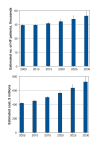The current and future financial burden of hospital admissions for heart failure in Canada: a cost analysis
- PMID: 27730101
- PMCID: PMC5047807
- DOI: 10.9778/cmajo.20150130
The current and future financial burden of hospital admissions for heart failure in Canada: a cost analysis
Abstract
Background: Heart failure is a costly health condition and a major public health concern. We sought to examine the costs of hospital admissions for heart failure between fiscal years 2004 and 2013 in Canada and to model the future costs to 2030.
Methods: Canadian Institutes for Health Information Discharge Abstract Database was used to identify admissions to hospital with heart failure as the primary diagnosis between fiscal years 2004 and 2013. Multiple linear regression models were used to calculate the trend in prevalence and extrapolate these to 2030. Canadian Institutes for Health Information patient cost estimates were used to identify costs of hospital admissions for heart failure. Generalized linear models were used to estimate average annual costs per heart failure patient. We conducted a sensitivity analysis including all admissions for heart failure in any diagnostic field.
Results: In 2013, 45 600 (95% confidence interval [CI]: 43 800-47 200) patients were admitted with heart failure as the primary diagnosis, accounting for $482 (95% CI $464-$500) million. By 2030, we estimate 54 000 (95% CI 49 000-60 000) patients and costs of $722 (95% CI $650-$801) million, with older adults (age ≥ 80 yr) accounting for 52% of costs. Including admissions for which heart failure was a secondary diagnosis increases the total cost to $2.8 (95% CI $2.6-$3.0) billion in 2030.
Interpretation: As in other developed countries, hospital costs related to heart failure in Canada are on the rise. Older adults are the main consumers of such hospital services. Strategies to improve outpatient care to reduce rates of admission for heart failure are needed.
Conflict of interest statement
Conflicts of Interest: None declared.
Figures
References
-
- Heidenreich PA, Albert NM, Allen LA, et al. American Heart Association Advocacy Coordinating CommitteeCouncil on Arteriosclerosis, Thrombosis and Vascular BiologyCouncil on Cardiovascular Radiology and InterventionCouncil on Clinical CardiologyCouncil on Epidemiology and Prevention; Stroke Council. Forecasting the impact of heart failure in the United States: a policy statement from the American Heart Association. Circ Heart Fail. 2013;6:606–19. - PMC - PubMed
-
- Jhund PS, Macintyre K, Simpson CR, et al. Long-term trends in first hospitalization for heart failure and subsequent survival between 1986 and 2003: a population study of 5.1 million people. Circulation. 2009;119:515–23. - PubMed
LinkOut - more resources
Full Text Sources
Other Literature Sources
Molecular Biology Databases
Research Materials


